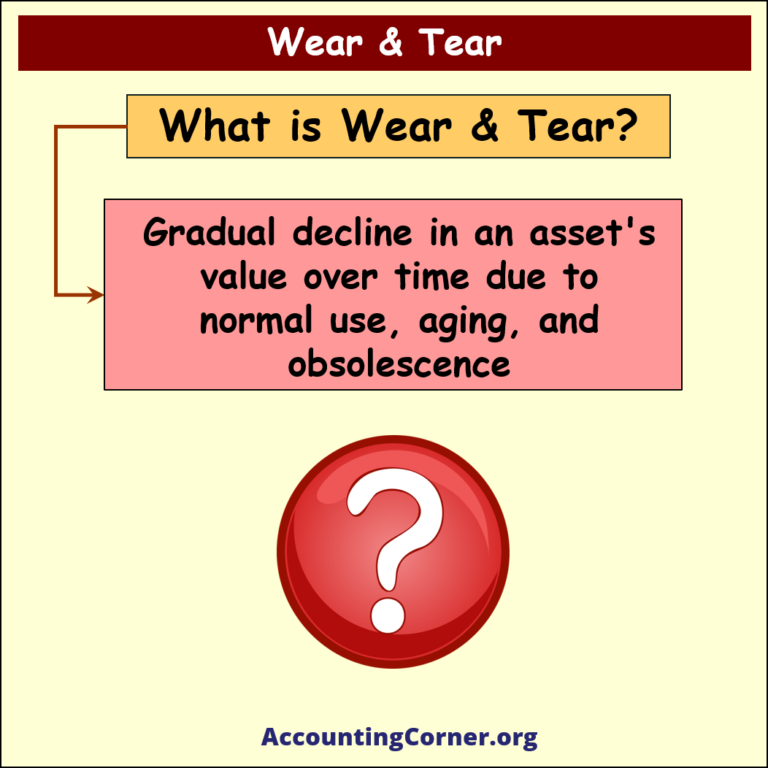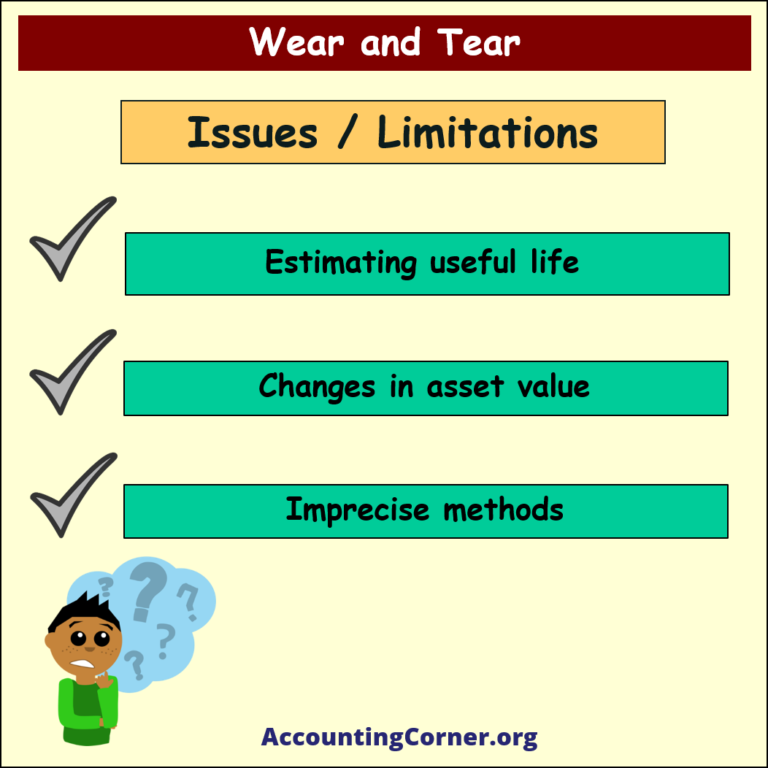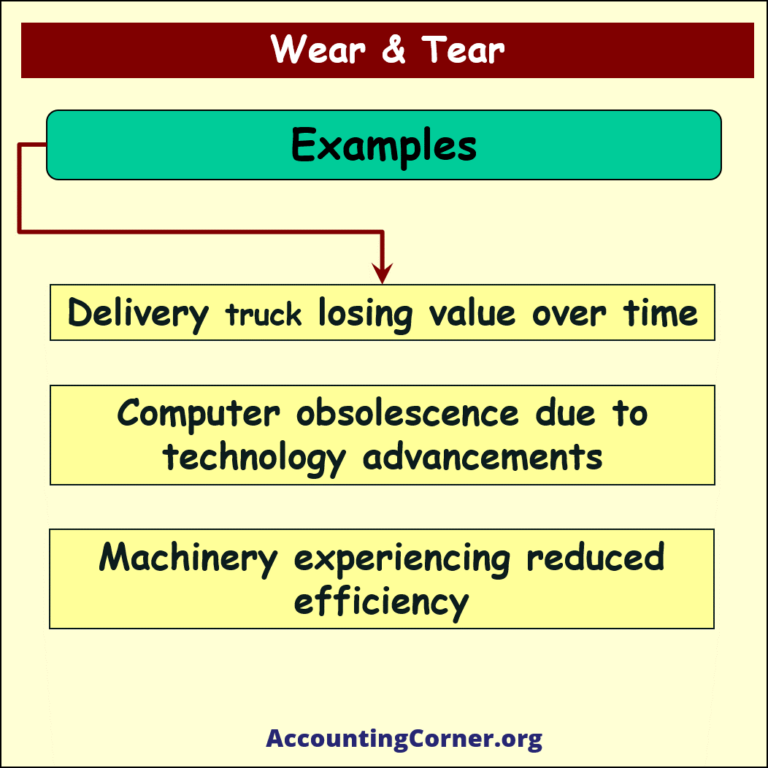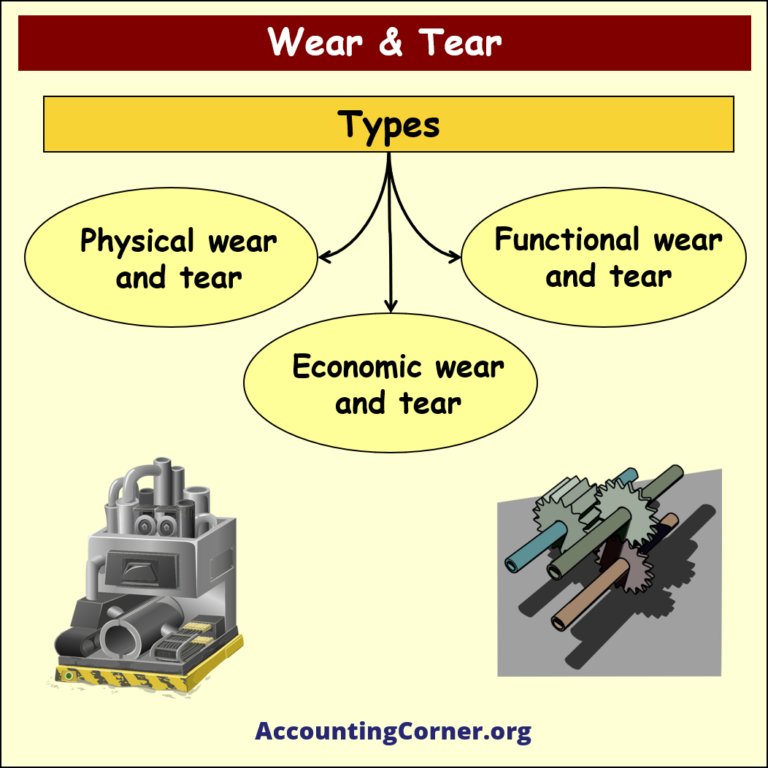Wear and Tear meaning
 Wear and tear in accounting and finance refer to the gradual decline in the value of an asset over time due to normal use, aging, and obsolescence. It is essential to account for wear and tear to accurately determine an asset’s value, maintain financial records, and calculate tax liabilities. The process of allocating the cost of an asset over its useful life is called depreciation.
Wear and tear in accounting and finance refer to the gradual decline in the value of an asset over time due to normal use, aging, and obsolescence. It is essential to account for wear and tear to accurately determine an asset’s value, maintain financial records, and calculate tax liabilities. The process of allocating the cost of an asset over its useful life is called depreciation.
Importance of wear and tear:
- Accurate financial statements: Accounting for wear and tear ensures that financial statements, such as the balance sheet and income statement, reflect the accurate value of assets and expenses.
- Tax benefits: Depreciation allows businesses to reduce their taxable income, as wear and tear expenses are tax-deductible.
- Capital budgeting: Factoring in wear and tear helps organizations plan for future asset replacements and maintenance expenses.

Types of wear and tear:
- Physical wear and tear: Results from the normal use of an asset, causing it to deteriorate over time.
- Functional wear and tear: Occurs when an asset becomes obsolete due to technological advancements or changes in market demand.
- Economic wear and tear: Refers to external factors, such as regulatory changes, that may impact an asset’s value or usefulness.

 Formula on wear and tear: One common method to calculate wear and tear (depreciation) is the straight-line method:
Formula on wear and tear: One common method to calculate wear and tear (depreciation) is the straight-line method:
Examples of wear and tear:
- A delivery truck gradually loses value due to mileage, weather, and aging.
- A computer becomes less valuable as newer models with improved capabilities are introduced to the market.
- A factory’s machinery experiences reduced efficiency as components wear out over time.
Issues and limitations of wear and tear:
- Estimating useful life: Determining an asset’s useful life can be subjective and may vary based on assumptions about usage, maintenance, and technological advancements.
- Changes in asset value: The value of an asset may change unexpectedly due to factors such as market conditions, making the depreciation schedule less accurate.
- Imprecise methods: Different depreciation methods can result in varying amounts of wear and tear expenses, which may impact financial statements and tax liabilities.
 In summary, wear and tear is a critical concept in accounting and finance, as it helps maintain accurate financial records and plan for future asset replacements and maintenance expenses. While there are some limitations and challenges in estimating wear and tear, it remains an essential aspect of financial management.
In summary, wear and tear is a critical concept in accounting and finance, as it helps maintain accurate financial records and plan for future asset replacements and maintenance expenses. While there are some limitations and challenges in estimating wear and tear, it remains an essential aspect of financial management.
Visual material: Wear and Tear
Video: Wear and Tear
The Most Popular Accounting & Finance Topics:
- Balance Sheet
- Balance Sheet Example
- Classified Balance Sheet
- Balance Sheet Template
- Income Statement
- Income Statement Example
- Multi Step Income Statement
- Income Statement Format
- Common Size Income Statement
- Income Statement Template
- Cash Flow Statement
- Cash Flow Statement Example
- Cash Flow Statement Template
- Discounted Cash Flow
- Free Cash Flow
- Accounting Equation
- Accounting Cycle
- Accounting Principles
- Retained Earnings Statement
- Retained Earnings
- Retained Earnings Formula
- Financial Analysis
- Current Ratio Formula
- Acid Test Ratio Formula
- Cash Ratio Formula
- Debt to Income Ratio
- Debt to Equity Ratio
- Debt Ratio
- Asset Turnover Ratio
- Inventory Turnover Ratio
- Mortgage Calculator
- Mortgage Rates
- Reverse Mortgage
- Mortgage Amortization Calculator
- Gross Revenue
- Semi Monthly Meaning
- Financial Statements
- Petty Cash
- General Ledger
- Allocation Definition
- Accounts Receivable
- Impairment
- Going Concern
- Trial Balance
- Accounts Payable
- Pro Forma Meaning
- FIFO
- LIFO
- Cost of Goods Sold
- How to void a check?
- Voided Check
- Depreciation
- Face Value
- Contribution Margin Ratio
- YTD Meaning
- Accrual Accounting
- What is Gross Income?
- Net Income
- What is accounting?
- Quick Ratio
- What is an invoice?
- Prudent Definition
- Prudence Definition
- Double Entry Accounting
- Gross Profit
- Gross Profit Formula
- What is an asset?
- Gross Margin Formula
- Gross Margin
- Disbursement
- Reconciliation Definition
- Deferred Revenue
- Leverage Ratio
- Collateral Definition
- Work in Progress
- EBIT Meaning
- FOB Meaning
- Return on Assets – ROA Formula
- Marginal Cost Formula
- Marginal Revenue Formula
- Proceeds
- In Transit Meaning
- Inherent Definition
- FOB Shipping Point
- WACC Formula
- What is a Guarantor?
- Tangible Meaning
- Profit and Loss Statement Template
- Revenue Vs Profit
- FTE Meaning
- Cash Book
- Accrued Income
- Bearer Bonds
- Credit Note Meaning
- EBITA meaning
- Fictitious Assets
- Preference Shares
- Wear and Tear Meaning
- Cancelled Cheque
- Cost Sheet Format
- Provision Definition
- EBITDA Meaning
- Covenant Definition
- FICA Meaning
- Ledger Definition
- Allowance for Doubtful Accounts
- T Account / T Accounts
- Contra Account
- NOPAT Formula
- Monetary Value
- Salvage Value
- Times Interest Earned Ratio
- Intermediate Accounting
- Mortgage Rate Chart
- Opportunity Cost
- Total Asset Turnover
- Sunk Cost
- Housing Interest Rates Chart
- Additional Paid In Capital
- Obsolescence
- What is Revenue?
- What Does Per Diem Mean?
- Unearned Revenue
- Accrued Expenses
- Earnings Per Share
- Consignee
- Accumulated Depreciation
- Leashold Improvements
- Operating Margin
- Notes Payable
- Current Assets
- Liabilities
- Controller Job Description
- Define Leverage
- Journal Entry
- Productivity Definition
- Capital Expenditures
- Check Register
- What is Liquidity?
- Variable Cost
- Variable Expenses
- Cash Receipts
- Gross Profit Ratio
- Net Sales
- Return on Sales
- Fixed Expenses
- Straight Line Depreciation
- Working Capital Ratio
- Fixed Cost
- Contingent Liabilities
- Marketable Securities
- Remittance Advice
- Extrapolation Definition
- Gross Sales
- Days Sales Oustanding
- Residual Value
- Accrued Interest
- Fixed Charge Coverage Ratio
- Prime Cost
- Perpetual Inventory System
- Vouching
Return from Wear and Tear to AccountingCorner.org home





